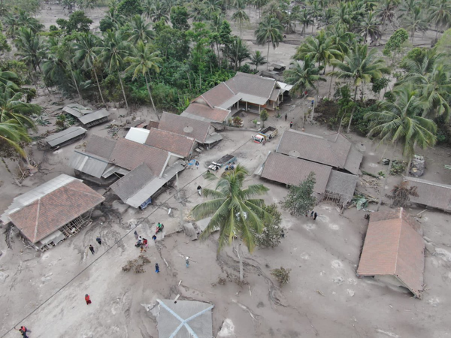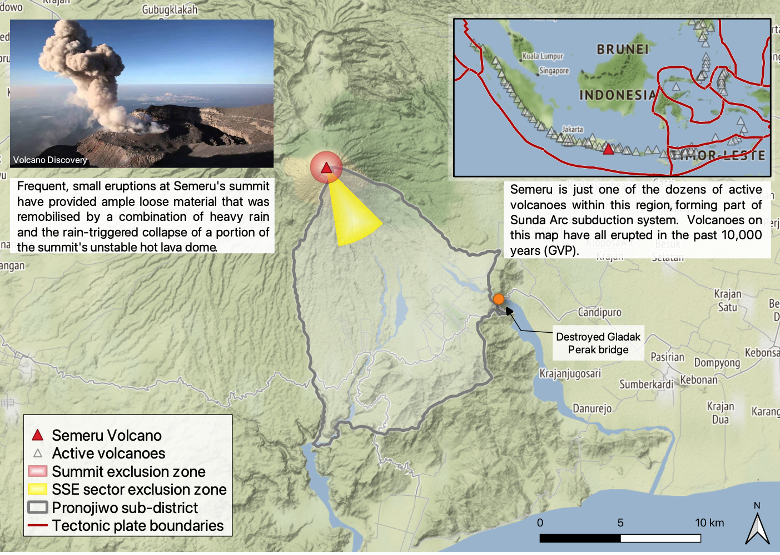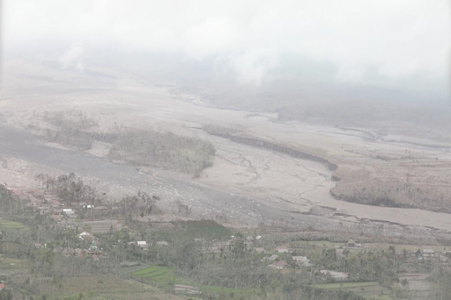Mount Semeru, one of Indonesia’s most frequently erupting volcanoes, caused havoc in East Java after heavy rainfall triggered the collapse of its lava dome on December 4. Explosions associated with the collapse sent towers of ash up to 40,000 feet in the air, shrouding nearby areas in complete darkness mid-afternoon. Images of the aftermath show houses and trucks buried meters deep by hot cement-like mixtures of rock and water that overflowed into settlements nearby and destroyed an important bridge, hampering evacuations and aid (Figure 1).

At the time of writing, 48 fatalities have been confirmed and dozens more are missing or have sustained burn injuries, some of which occurred after people waded into the hot volcanic mixtures, mistaking them for typical floodwaters. Search and rescue efforts to extract missing people, some of whom are believed to be trapped inside buildings or in their vehicles, ceased temporarily as continued explosions threatened impacted areas once again.

Was There a Warning Prior to the Event?
Semeru almost constantly produces relatively small eruptions, and this high level of activity makes forecasting larger events particularly challenging, even for highly experienced groups such as Indonesia’s Centre for Volcanology and Geological Hazard Mitigation (CVGHM). CVGHM reported on December 5 that throughout November Semeru had been producing roughly 50 “eruption earthquakes” per day accompanied by small explosions, which is not abnormal for this volcano.
CVGHM also reported that the current larger event was triggered by heavy rainfall interacting with and eroding the hot and unstable mass of lava accumulated within the summit of the volcano. Java’s monsoon season runs from November to March and given the last eruption of similar magnitude also occurred in early December in 2020, it can perhaps be expected that these wetter months are now more likely be accompanied by increased volcanic hazard at Semeru.

What Impacts Has This Event Caused?
In addition to the injuries and casualties reported, this event caused widespread panic, displaced more than 2,000 from their homes, and inundated several villages located near rivers that drain the southeastern side of the volcano. At least 30 buildings have been destroyed by lahars (volcanic debris flow) and at least 2,000 structures have reportedly been damaged by lahars and ashfall in the Pronojiwo District, immediately southeast of the volcano. The eruption also caused power outages for more than 30,000 people and made some roads in the area inaccessible.
Could Climate Change Impact Eruptions and Vice-Versa?
The relationship between climate change and volcanic eruptions became a hot research topic following the immense and devastating 1991 eruption of Mount Pinatubo in the Philippines. The enormous volumes of gas and volcanic particulate matter ejected into the stratosphere by this eruption, the second largest of the 20th century, triggered a 0.5˚C cooling that persisted for three years.
The most powerful eruption in recorded human history, from Tambora in Indonesia in 1815, caused cooling that has been dubbed the “Year Without a Summer,” which triggered years of crop failures as far away as the United States and Europe. This cooling effect occurs when volcanic sulfate aerosols are injected into the stratosphere by powerful volcanic eruptions and disperse to prevent normal amounts of sunlight from reaching the Earth’s surface.
A recent study published in Nature noted that in a warming climate the height of the stratosphere is predicted to increase, so fewer eruptions will be able to reach the stratosphere to efficiently cool the Earth. Conversely, the study found that when large eruptions do manage to reach the stratosphere, their aerosols will likely spread faster and remain at an ideal size for scattering sunlight for longer. This means eruptions that are already extreme are likely to have an increased cooling effect and are thought likely to amplify cooling at the surface by 15%.
If climate change is driving increases in extreme rainfall events, there are three known ways this will increase the risk posed by volcanic eruptions.
First, heavy rain can infiltrate and disturb certain volcanic systems, triggering eruptions that might not have otherwise occurred or been as severe, as was just seen at Semeru. Similarly, in Hawaii in 2018, unusually heavy rain is thought to have weakened volcanic rocks on the flanks of Kilauea, perhaps serving as the trigger for its most recent damaging eruption where more than 500 buildings were destroyed by lava despite there being no major influx of fresh magma beforehand.
Second, extreme rainfall on volcanic edifices can initiate sudden lahars that can be difficult to forecast and are often deadly. Such an event occurred at Mayon volcano in the Philippines following the landfall of Super Typhoon Rolly in November 2020.
Finally, when extreme quantities of rainfall are absorbed by dry volcanic ashfall deposits after an eruption, this can substantially increase the weight of the ash, thereby increasing its potential to trigger life-threatening and costly roof collapses.
Growing Exposure, Growing Risk
Regardless of climate change’s potential to exacerbate volcanic risk, population growth within areas threatened by volcanic hazards remains a key driver of risk. More than 1 billion people live within 100 km of active volcanoes globally and a recent analysis found that populations close to volcanoes have been increasing faster than the global average for several decades. The rapidly developing science of volcano monitoring and improved early warning systems save lives by buying time for evacuations, but they also make communities feel safer building within areas threatened by volcanic hazards.
This increased safety margin may explain why developed areas within 100 km of active volcanoes have more than doubled (from 16,000 to 39,000 km2) since the 1970s. As exposure continues to increase globally, it can be expected that the world will begin to see impactful eruptions like that at Semeru more frequently. To address this growing risk volcanology researchers are increasingly turning to large-scale volcanic hazard and risk modeling to better identify hazardous areas and rank and quantify risks in different volcanically active regions around the world.
References
Aubry TJ, Staunton-Sykes J, Marshall LR, et al (2021) Climate change modulates the stratospheric volcanic sulfate aerosol lifecycle and radiative forcing from tropical eruptions. Nature Communications 12.
Farquharson, J.I., Amelung, F. Extreme rainfall triggered the 2018 rift eruption at Kīlauea Volcano. Nature 580, 491–495 (2020).
Williams GT, Jenkins SF, Lee DWJ, Wee SJ (2021) How rainfall influences tephra fall loading — an experimental approach. Bulletin of Volcanology 83:42.
Freire S, Florczyk A, Pesaresi M, Sliuzas R (2019) An Improved Global Analysis of Population Distribution in Proximity to Active Volcanoes, 1975 - 2015. ISPRS Int J Geo-Information 8:341.
Jenkins SF, Biass S, Williams GT, et al (2021) Evaluating and ranking Southeast Asia’s exposure to explosive volcanic hazards. Natural Hazards and Earth Systems Science 1–49
Explore the sensitivity of catastrophe risk to a changing climate with AIR's Climate Change Practice




